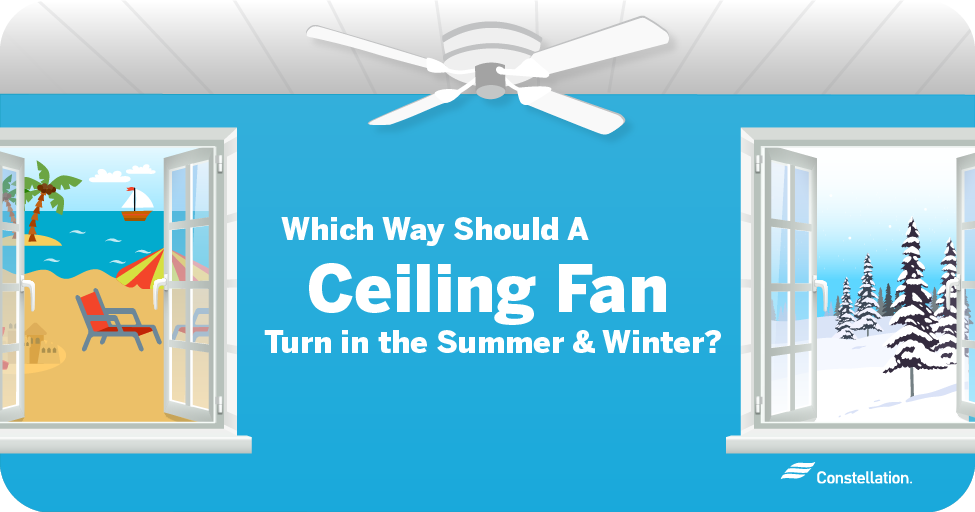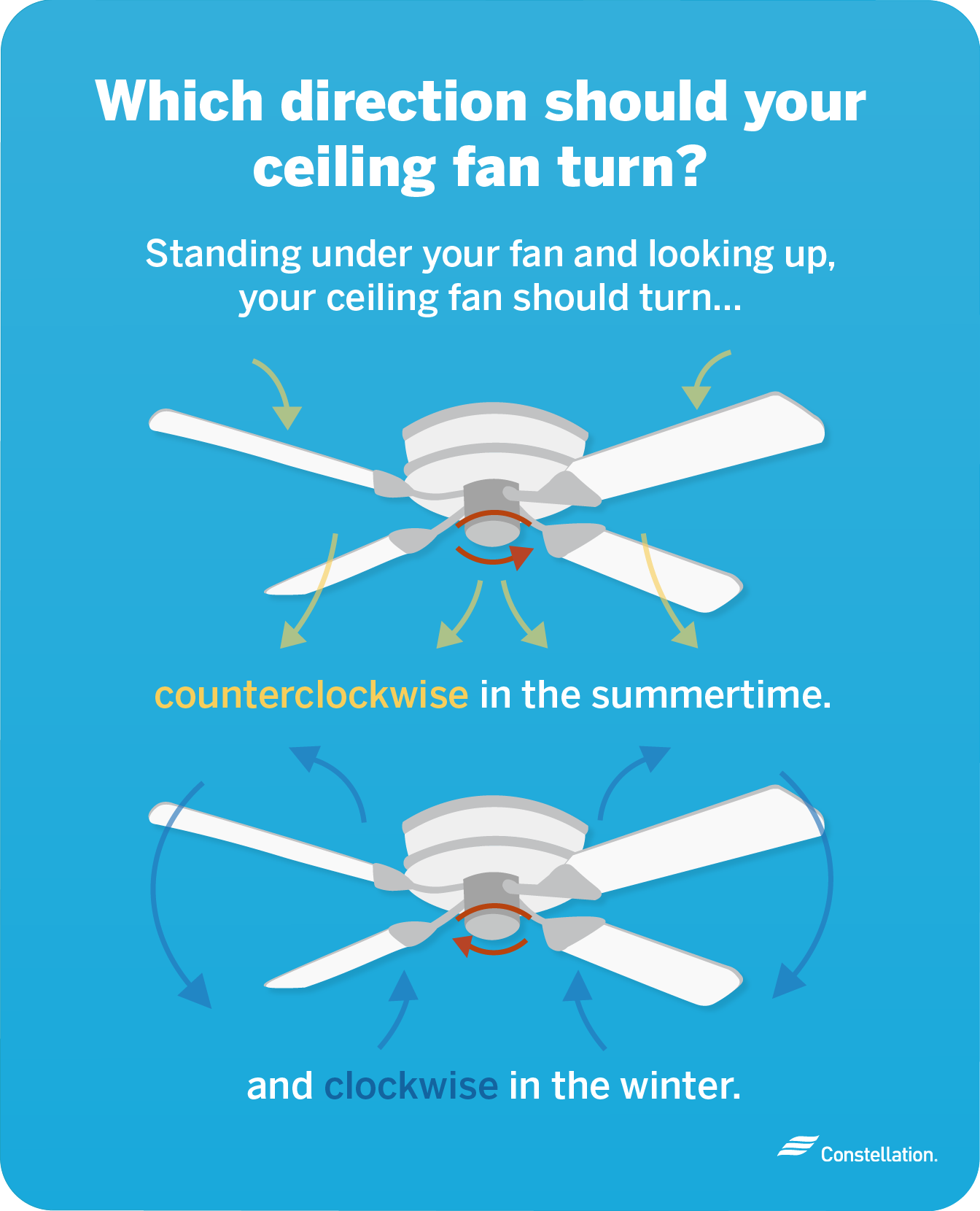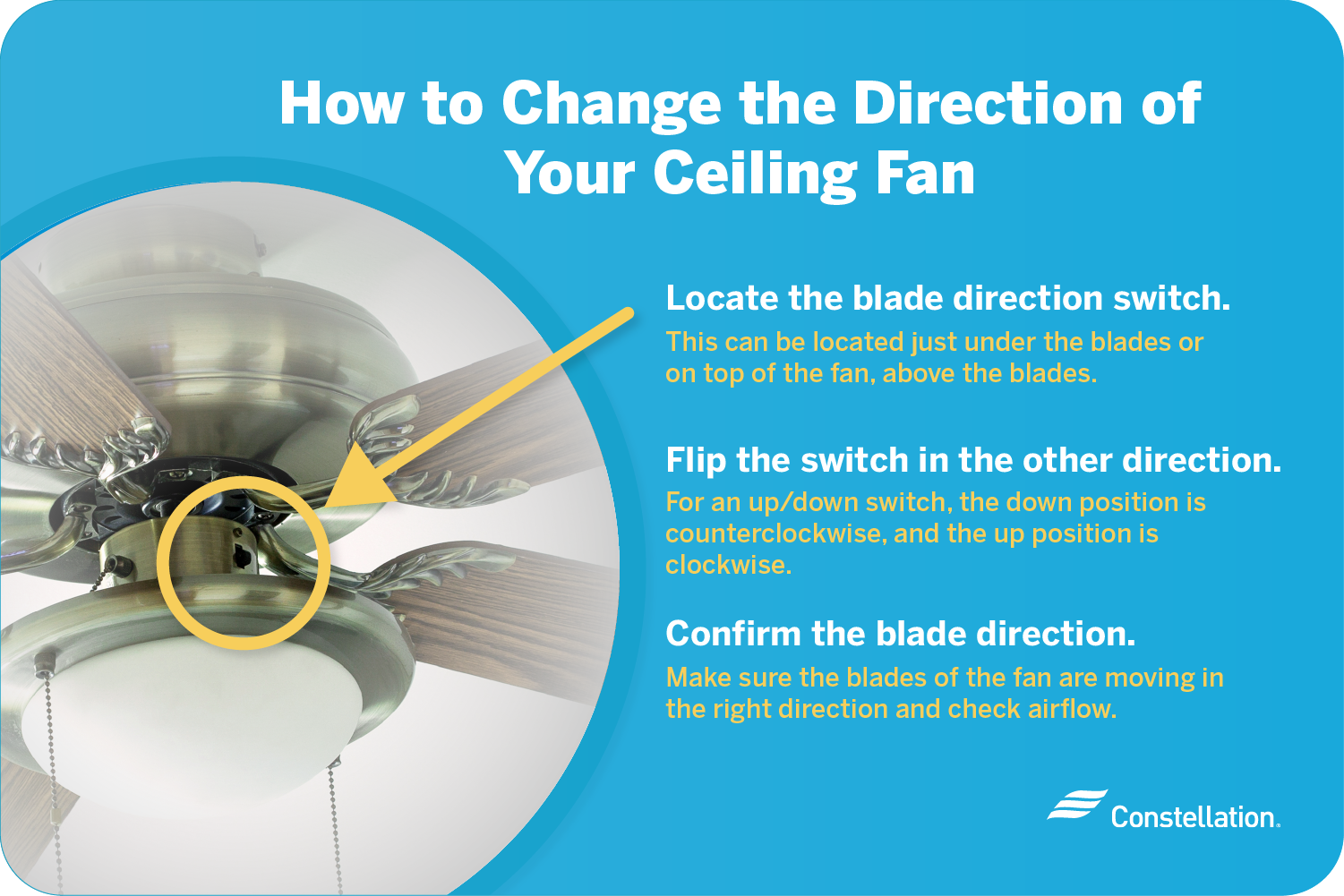
- Category:
Energy Efficiency - Published:
July 16, 2020 - Updated:
May 3, 2022
Which Way Should a Ceiling Fan Turn in the Summer & Winter?
When temperatures go up, often so does air conditioning usage. But A/C can use a lot of electricity, which may be expensive. That’s why it could pay to find alternatives to air conditioning that use less energy, like ceiling fans. Whether you run them instead of the A/C or together, a ceiling fan may possibly help reduce your home energy usage. The only catch is knowing the correct ceiling fan direction for summer.
The direction your ceiling fan blades rotate can help disperse heat and cool air throughout the house. By changing the rotation of your ceiling fans for summer and winter, you could reduce the amount of energy other appliances need to keep your home cool or warm during the year.
Using the correct fan direction in summer and winter can make a significant difference in the way a home is heated and cooled.
Use ceiling fans to make rooms feel cooler during the summertime
In summer, you want your ceiling fan to push cold air down toward the floor. It takes energy to keep the house cool, but ceiling fans make people feel cooler without raising your energy bill. The breeze makes perspiration on your skin evaporate, creating a wind chill effect. People under a ceiling fan can feel several degrees cooler than the room’s actual temperature. By running your ceiling fan in the direction for cooling, you may rely on air conditioning less and possibly help save energy in your home.
As mentioned, ceiling fans cool people, not rooms. They just affect airflow in the room they’re mounted above. So, when you leave the room, save energy by turning off the ceiling fan.
Which direction should a ceiling fan turn in the summer?

The correct ceiling fan direction for summer is counterclockwise. Running the blades in that direction ensures that the air blows straight down. As you stand under the fan and look up, you’ll see the blades start at the top left, move down and finally make their way up the right side to the top again.
More importantly, you should also feel the telltale breeze that means you’ve successfully set your ceiling fan direction for cooling. If you can’t feel anything yet, try increasing the fan’s speed.
Using ceiling fans to help save on heating in the winter
As much as ceiling fans can keep a house cool in the summertime, they can also evenly disperse heat throughout the home. Reversing the direction, the ceiling fan blades rotation can effectively push heated air down and move it through the home. In doing this, you could cut heating costs by reducing the amount of energy needed to maintain a comfortably warm temperature. It may seem counterintuitive but using a ceiling fan in the winter may help you feel warmer and possibly save on heating bills.
Which direction should a ceiling fan turn in the winter?
The correct ceiling fan direction for winter is clockwise. When set at a low speed, your ceiling fan draws cool air up and forces warm air down. Redistributing warm air that collects near the ceiling helps make your room feel warmer and keeps you from needing to use more energy to raise the temperature.
To make sure your ceiling fan direction is right for warming, stand under the ceiling fan and look up. You should see the blades rotating in the direction the hands of a clock move: starting at top right, moving down and back up the left side to the top again. The speed should be set to low. You shouldn’t feel a breeze coming down.
How to change a ceiling fan’s direction for summer & winter
How does one change the ceiling fan direction? The most important thing is locating the switch that controls blade rotation. Traditional ceiling fan models have a toggle switch on the housing just underneath the blades. (Sometimes the switch is on top of the fan above the blades.) Some ceiling fans can be reversed by pressing a button on a wall-mounted control. Others come with remote controls, and smart ceiling fans can even be controlled with an app. (If you can’t locate the switch that changes the blade rotation, consult the user manual that came with the fan or call the manufacturer.)
If you don’t have the ability to change your ceiling fan direction from the floor, you’ll need to climb up and change the blade rotation by hand. This may bring up some questions such as which way to turn the ceiling fan switch, up or down in summer. The following steps can help you.

Steps to take when switching the direction of your ceiling fan by hand:
- Turn off the ceiling fan. Many traditional models have cords or chains that hang down from the center. Each pull switches the ceiling fan’s speed and turns it off and on.
- WAIT FOR THE BLADES TO COMPLETELY STOP MOVING. Safety first! The blades can injure you if they’re still moving. Make sure they come to a complete stop.
- Get a sturdy ladder. Inspect it first to make sure your ladder is safe for use. You should have someone hold the base of the ladder for support.
- Clear furniture or other obstacles underneath the ceiling fan. You should be able to set up your ladder directly under the fan. You shouldn’t have to stretch to reach the switch.
- Set up the ladder. You want it close enough so that you can easily reach the blade direction switch.
- Locate the blade direction switch. Many ceiling fans have it on the housing, just under the blades. It may also be on top of the fan, above the blades.
- Flip the switch in the other direction. If it’s a vertical (up/down) switch, the down position is the ceiling fan direction for summer, and the up position is the direction for winter. (Think pushing air down and pulling air up.) For horizontal (side-to-side) switches, the left position should be the summer setting and the right position should be the winter setting.
- Turn the ceiling fan back on. Make sure you’re safely out of the way of the blades beforehand, though. If you choose the ceiling fan direction for winter, make sure the speed is set to low.
- Confirm the blade direction. Look up to make sure the blades of the fan are moving in the right direction: counterclockwise for summer, clockwise for winter.
What ceiling fans are best for the winter and summertime?
The ceiling fan that’s best for your summer and winter use will depend on where it’s going and how much you want to spend. You’ll definitely want one with multiple speeds. You may want one that doubles as lighting, or that runs silently. And if you want to avoid climbing up and reversing the direction by hand, you should look for ceiling fans that have a wall-mounted or remote control.
Smaller rooms will be served well by smaller ceiling fans; bigger rooms will need larger, more powerful models and possibly multiple units. The larger the fan, the more energy used. To cut down on energy use, you may want to get a ceiling fan with an ENERGY STAR® rating, which is 40% more efficient than a traditional ceiling fan. If your ceiling fan has lights, use LED bulbs for increased energy efficiency. You could also save energy by turning fans off when you leave the room.
And if you’re looking for additional ways to reduce A/C use and improve energy efficiency, you may want to look into other types of fans. Summer energy efficiency tips can help you stay cool all season long.
Ceiling fan tips for each room of the house
Ceiling fans are suitable for indoor and outdoor use and can be mounted in nearly every room of your house. Size, type and installation will vary by location. Many also double as lighting, which may factor into your decision.
- Ceiling fans in a bedroom — Keeping air circulating at night will help keep you cool and get a better night’s sleep in summer. Light sleepers will want a model that runs silently. And unless you have a very large bedroom, you’ll probably want a smaller ceiling fan with a flush mount (anchored only a few inches below the ceiling).
- Ceiling fans in a bathroom or kitchen — Keeping air circulating in bathrooms and kitchens can help regulate temperature. However, those rooms often fill up with moisture, which can damage indoor-only models. Choose a ceiling fan with a damp rating for these rooms.
- Ceiling fans in the living room — You’ll want a larger model for your living room or great room. Ceiling fans are most effective when their blades are about 8 or 9 feet off the floor, so you may need a downrod mount. A downrod simply lowers the fan from the mount secured to the ceiling. Pro tip: If your ceiling fan has been idle for a long time, dust the blades before you start it up again. Your family will breathe easier without all those dust particles kicked up into the air.
- Ceiling fans in the dining room — Cool, circulating air can make for a pleasant summer dinner. But if you want a ceiling fan in your dining room, make sure you don’t install a more powerful fan than you need. You don’t want too much air blowing down on your family and guests. Look for a model with a low-speed option. Also, moving dining room furniture out of the way to change the ceiling fan direction can be taxing. If possible, you may want to consider a fan model that can be controlled remotely.
- Ceiling fans for outdoor use — If Mother Nature isn’t cooperating with a nice breeze, a ceiling fan can be just the thing. Just make sure you get one that’s wet-rated, which means it won’t be damaged by the elements. If the area you want to cool won’t be directly exposed to rain, snow or ice, you may be able to get away with a damp-rated ceiling fan. Fans with a dry rating are meant for indoor use only and should never be used where they’ll be exposed to any moisture.
Staying cooler when it’s hot and warmer when it’s cold — and cutting energy consumption year-round — can be as simple as knowing the right ceiling fan direction for summer or winter. But using fans is just one of many energy-saving tips for summer and winter. With some wise investment in the right equipment and some thoughtful changes to your daily routine, you can potentially lower your cooling and heating use during the year’s peak months.




